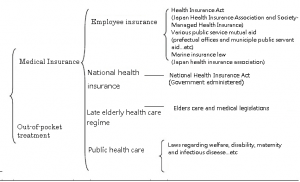Health Insurance System in Japan
May 17, 2017

Health insurance system in Japan works on several levels and may be not widely understood. This article will focus on the public health care regime and the differentiation between insured treatment (保険診療), out-of-pocket treatment (自由診療) and mixed treatment (混合診療). There are of course also insurance offered by private health insurance companies that individuals may join at their own accord, however, that will not be covered in this article.
The Japanese public health insurance has three features:
1. All residents have health insurance of some kind;
2. Medical treatment is administered first and the insurance pays the medical institution afterwards;
3. Patients can chose where to obtain medical care.
For general understanding, the chart below shows how the medical insurance stream branches out to separate regimes supported by particular legislations.

The Ministry of Health, Labour and Welfare has published an overview to explain the Japanese system:
http://www.mhlw.go.jp/bunya/iryouhoken/iryouhoken01/dl/01_eng.pdf
Generally, full-time employees benefit from employer contributions towards their health insurance. Depending on the size of the company and industry, that health insurance may be society-managed health insurance, mutual aid, union fund or some other structured fund. Most commonly, however, it is the National Health Insurance Scheme.
Residents who do not receive health insurance through their employers are required to enrol into the National Health Insurance themselves in order to receive benefits toward their medical expenses. The insurance fee is calculated according to each individual’s income and personal circumstances.
As explained in the overview, the co-payment scale (in other words, out-of-pocket fees the patient needs to pay) differ depending on factors such as age, income and the cost of treatment. Commonly patients are liable for 30% of medical expenses.
Some illness (conditions) are not covered by public health insurance (although may be covered by other regimes). For example, natural childbirth, workplace injury, injury as a result of incidents such as fights and drunkenness, advanced optional treatments, second opinion, periodic check-ups and self-inflicted injury.
“Insured Treatment”, “Out-of-pocket treatment” and “Mixed Treatment”
As the name of categories suggest, treatments covered by public insurance is categorised as Insured Treatment (保険診療); treatments not covered by public insurance is Out-of-pocket Treatment (自由診療). In specific circumstances where there is a mix of both insured and out-of-pocket treatment, a special Mixed Treatment (混合診療) may be permitted.
In principal, however, when a patient undergo treatments involving both Insured Treatment and Out-of-pocket Treatment it does not mean it is recognised as Mixed Treatment. Unless certain criteria are met to achieve the Mixed Treatment recognition, the patient is liable for all expenses including the Insured Treatment part.
This is confirmed by a High Court case in 2011 involving a cancer patient who underwent Interferon-γ treatment インターフェロン療法 (Insured Treatment) and Autologous Activated Lymphocytes treatment活性化自己リンパ球移入療法 (Out-of-pocket treatment). The patient initiated the lawsuit and claimed that the Insured Treatment should be covered by his insurance. The five judges unanimously dismissed the plaintiff’s claim. However, four judges also commented on the need to make necessary legislative amendments to clarify the law.
http://www.courts.go.jp/app/files/hanrei_jp/724/081724_hanrei.pdf
http://www.spmed.jp/14_kankei/qa_pdf/23_qa/qa_H2312.pdf
High Cost Medical Treatment System
One example of how Mixed Treatment may be recognized is through the High Cost Medical Treatment System. The High Cost Medical Treatment System relates to 103 types of conditions. The regime is potentially subject to change over time and it is recommended to check the official Ministry website regarding its development:
http://www.mhlw.go.jp/stf/seisakunitsuite/bunya/kenkou_iryou/iryouhoken/sensiniryo/index.html
In short, the expenses from the “high cost medical treatment” are differentiated from the general medical expenses. The patient is liable to pay for the “highly cost medical treatment” while the general medical expenses are subject to the ordinary co-payment scale. Notification to the governmental department regarding High Cost Medical Treatment is required and information such as the specific treatment would need to be provided.
Medical treatment is a field that is easily acceptable to changing due to advancing technology. The government is allowing advance medical provider companies to establish in specific zones. We hope to cover this topic in our future blog post.
You are welcome to contact us via the Contact Form to discuss and for more information.
